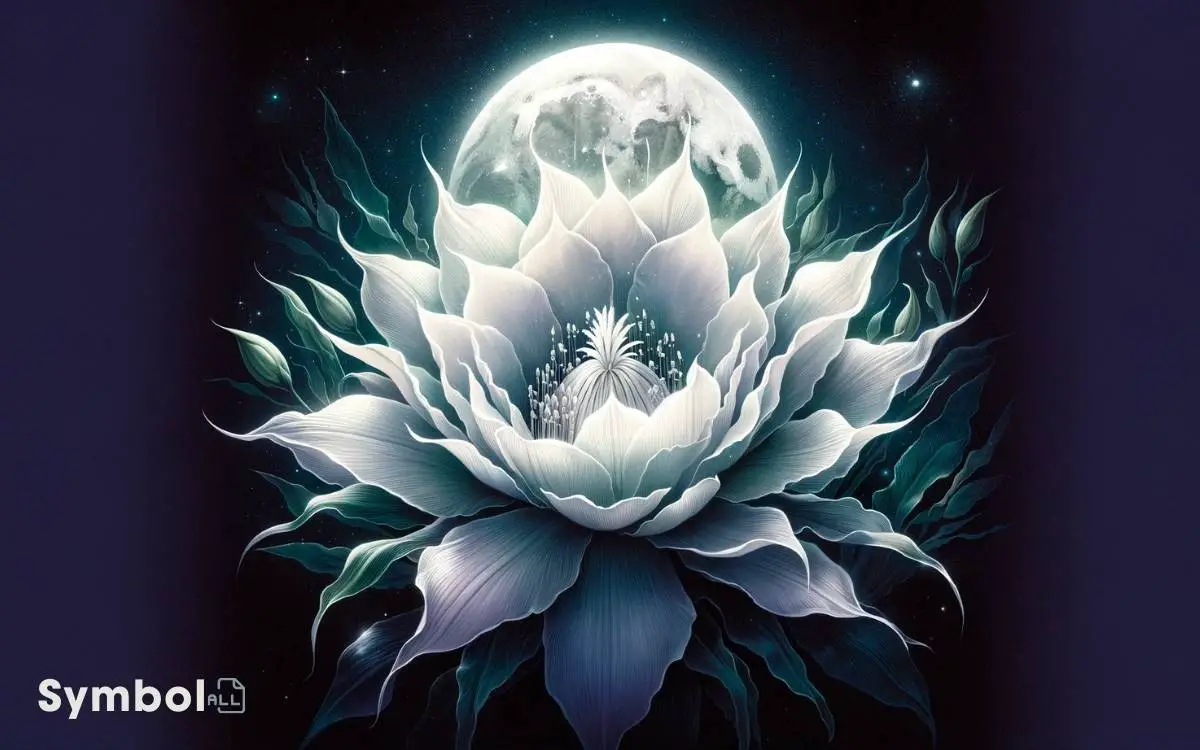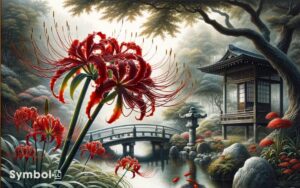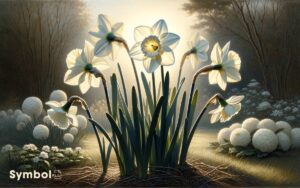Queen of the Night Flower Symbolism: Mystery And Magic!
You’re delving into the Queen of the Night flower, a symbol steeped in mystery and magic. Its ephemeral bloom, occurring under the cloak of darkness, epitomizes transience and impermanence.
This flower’s intricate circadian rhythm, fine-tuned to environmental cues, reflects not only a marvel of botanical adaptation but also cultural significance across histories and mythologies.
It represents a myriad of human emotions, from love and desire to resilience and adaptability. Cultures have imbued it with spiritual meanings of rebirth and transcendence, reflecting a deep appreciation for its fleeting beauty.
This rare beauty’s symbolism extends into various domains, hinting at an intricate relationship between nature and human perception, suggesting there’s much more beneath its surface.

Key Takeaways
The Mysterious Bloom
Rarely does a flower captivate the imagination and intrigue botanists as much as the Queen of the Night, which blooms under the cover of darkness with a precision that defies simple explanation.
You’re delving into a phenomenon where a plant’s flowering mechanism aligns with nocturnal rhythms, an adaptation that’s both fascinating and complex.
This timing isn’t coincidental but a result of evolutionary processes, ensuring pollination efficiency by specific night-active pollinators.
The flower’s ability to regulate its bloom, opening at such a precise moment, highlights a sophisticated biological clock.
This internal timing mechanism, or circadian rhythm, is finely tuned to environmental cues, primarily light and temperature.
Understanding its functionality offers insights into plant behavior, ecological relationships, and the underlying genetics of phenological events, presenting a compelling study subject for those seeking to comprehend the intricacies of plant life.
Historical Significance
Delving into the historical significance of the Queen of the Night flower, one discovers its profound impact on cultural and religious practices across various civilizations.
This nocturnal bloomer, scientifically known as Epiphyllum oxypetalum, has been revered for centuries, not just for its rare beauty but also for its symbolic meanings, which resonate across different cultures.
To understand its significance, consider the following:
- Medicinal Uses: In traditional medicine, various cultures have utilized the plant for its purported healing properties, ranging from antiseptic applications to soothing digestive issues.
- Religious Symbolism: The flower’s ephemeral bloom has symbolized themes of life, death, and rebirth, integrating seamlessly into rituals and mythologies.
- Artistic Inspiration: Artists and poets have often drawn inspiration from the fleeting beauty of this flower, using it as a metaphor for transient life and eternal themes.
Through these lenses, the Queen of the Night’s historical significance is multidimensional, blending practical uses with deeper symbolic interpretations.
Cultural Interpretations
Building on its historical significance, the Queen of the Night flower holds varied cultural interpretations that reflect its symbolic versatility across different societies.
In some cultures, this rare bloom symbolizes mystery and magic due to its nocturnal blooming pattern.
Scientifically known as Selenicereus grandiflorus, its fleeting appearance under the moonlight has led to associations with enigmatic and ephemeral beauty, deeply revered in artistic and literary circles for these qualities.
Additionally, different societies imbue the flower with spiritual meanings, viewing it as a bridge to the divine or the supernatural.
Its unique blooming process, which occurs just once annually, has been interpreted as a sign of rarity and preciousness, making it a coveted symbol in rituals that honor life’s fleeting nature.
Symbol of Transience
The Queen of the Night flower epitomizes transience with its once-a-year bloom, revealing nature’s fleeting beauty through a precise, ephemeral display. This rare occurrence serves as a powerful symbol, embodying the temporary nature of life itself.
It prompts you to reflect on the transient aspects of existence, urging a deeper appreciation for moments that, once passed, may never return.
To convey its deeper meaning, consider:
- Impermanence: Its brief lifespan is a stark reminder of life’s impermanent nature.
- Momentary Beauty: The flower’s fleeting beauty symbolizes the ephemeral nature of aesthetic and material pursuits.
- Urgency of Appreciation: Its rarity and short-lived bloom encourage an immediate and profound appreciation of the present moment.
This analysis invites a scientific appreciation for the Queen of the Night, emphasizing the importance of transient phenomena in the natural world.
Love and Desire
Beyond its transient beauty, the Queen of the Night flower also embodies profound themes of love and desire, revealing how these powerful emotions are deeply rooted in the natural world.
In botanical terms, the flower’s rare blooming cycle and intoxicating fragrance are nature’s strategies for attracting pollinators.
However, metaphorically, these characteristics symbolize the fleeting nature of love and the intense desire that can drive individuals together.
Just as the flower opens under the cloak of night, love often blossoms in unexpected conditions, thriving on the elements of surprise and rarity.
The Queen of the Night’s ephemeral existence underscores the idea that love, while potentially brief, can leave a lasting impact, much like the flower’s fleeting yet unforgettable presence in the natural world.
Connection to the Moon
Delving into its celestial symbolism, the Queen of the Night flower shares a profound connection with the moon, reflecting its phases and embodying the cyclical nature of life and love.
This connection isn’t merely poetic but is rooted in the flower’s unique behaviors and adaptations that mirror lunar influences.
Here’s a deeper analysis:
- Bloom Cycle: Mirroring the moon’s phases, the flower blooms nocturnally, peaking in beauty under the full moon, which aligns with the peak of lunar gravitational pull, affecting terrestrial water and possibly influencing sap flow in plants.
- Growth Rhythms: The plant exhibits a form of circadian rhythm, opening at night when moonlight is present, suggesting an evolved response to lunar illumination for pollination strategies.
- Symbolic Resonance: In various cultures, the moon represents cycles, transformation, and renewal, qualities embodied by the ephemeral bloom of the Queen of the Night, reinforcing its symbolic connection to the lunar entity.
Feminine Mystique
You’ve witnessed the Queen of the Night‘s enigmatic allure, embodying the essence of nights filled with enchantment.
This flower’s blooming process under the moonlight symbolizes the revelation of mysterious beauty and the validation that nature bestows upon feminine energy.
Through its rare and enthralling presence, it serves as a confirmation to the strength and mystique inherently linked with the feminine.
Mysterious Beauty Unveiled
The Queen of the Night flower embodies a complex interplay of symbolism and femininity, enchanting observers with its enigmatic allure and ephemeral beauty. This flower’s mystique isn’t merely superficial; it’s deeply rooted in its biological and cultural significance.
- Biologically Unique: It blooms for a single night, a rare adaptation that reduces competition for pollinators in its native desert environment.
- Symbol of Feminine Power: Its fleeting beauty and nocturnal blooming pattern have led cultures to associate it with feminine mystique, embodying strength, mystery, and resilience.
- Cultural Significance: In various traditions, it represents the unattainable or the transient nature of life, encouraging a deeper appreciation for fleeting moments of beauty.
Understanding these aspects, you gain insight into the flower’s symbolic depth, transcending its visual appeal to embody profound themes of life, femininity, and mystery.
Nights Enchanting Essence
As night descends, the Queen of the Night flower reveals its enigmatic beauty, encapsulating the essence of feminine mystique through its unique nocturnal blooming. This phenomenon, rare among flora, symbolizes the complex layers of femininity subtle yet profound.
Scientifically, its timing to unfurl under moonlight isn’t merely aesthetic but a sophisticated adaptation for pollination, primarily attracting nocturnal pollinators.
This strategic blooming period mirrors the depths of feminine energy intuitive, nurturing, yet fiercely independent.
The flower’s ephemeral nature, blooming for a single night before vanishing at dawn, highlights the transient yet impactful essence of femininity.
It’s a reminder of the strength and resilience within vulnerability, showcasing how the most fleeting moments can leave a lasting impression.
Empowerment Through Nature
Drawing on the Queen of the Night’s unique nocturnal blooming, it’s evident that nature’s rhythms offer profound insights into feminine empowerment.
This exquisite flower, blooming singularly in the darkness, symbolizes the untapped potential and strength inherent within the feminine mystique.
Its rare appearance and enchanting scent highlight three key aspects:
- Resilience: Thriving in the moonlight, the flower demonstrates resilience and the ability to flourish under challenging conditions.
- Mystery: Its elusive blooming pattern mirrors the complex layers of feminine energy and intuition.
- Transformation: The night-time opening signifies growth and the transformative power of embracing one’s true self.
These characteristics serve as metaphors for the journey of self-discovery and empowerment that many women navigate, reinforcing the idea that beauty and strength emerge from the most unexpected places.
Spiritual Meanings
In examining the Queen of the Night flower, one finds that its spiritual symbolism is deeply rooted in notions of rebirth and transcendence, reflecting its rare and fleeting bloom.
This ephemeral nature mirrors the human soul’s journey toward enlightenment, emphasizing the transient nature of physical existence and the eternal aspect of the spiritual domain.
Its blooming at night, under the cover of darkness, symbolizes the idea that true spiritual awakening often occurs away from the daylight of conscious awareness, in the depths of the subconscious mind.
The flower’s dramatic reveal, from a seemingly unremarkable bud to a magnificent bloom, illustrates the potential for transformation and enlightenment within each individual.
The Queen of the Night serves as a profound metaphor for spiritual awakening and the pursuit of higher consciousness.
Themes of Duality
Delving into the themes of duality, the Queen of the Night flower embodies a striking contrast between its nocturnal blooming and the daytime dormancy, illustrating the complex interplay between light and darkness in nature.
This duality serves a deeper meaning:
- Adaptation: It highlights the evolutionary adaptation strategies plants employ for survival, optimizing pollination by attracting specific nocturnal pollinators.
- Balance: Reflecting the balance within ecosystems, this duality emphasizes the importance of both diurnal and nocturnal processes in maintaining ecological equilibrium.
- Symbolism: It symbolizes the coexistence of opposing forces within the natural world, mirroring the human experience where light and darkness, metaphorically, play essential roles in shaping perceptions and experiences.
Understanding this duality enriches your appreciation of the natural world’s complexity and beauty.
Rare Beauty Appreciation
You’ll discover that revealing hidden gems in the world of botany allows for a deeper appreciation of nature’s intricacies.
Cherishing fleeting moments with the Queen of the Night flower underscores the ephemeral beauty that requires precise timing and conditions to witness.
Embracing nature’s rarity, you come to understand the ecological and evolutionary factors that contribute to such phenomena, enhancing your grasp of biodiversity’s value.
Unveiling Hidden Gems
Every bloom of the Queen of the Night flower offers a rare glimpse into the world of botanical wonders, showcasing nature’s ability to craft beauty in fleeting, nocturnal moments.
This unique flowering event serves as a perfect metaphor for the rarity and fleeting nature of beauty in the natural world.
- Biological Rarity: The flower’s sporadic blooming cycle underscores the unpredictable and often ephemeral nature of ecological phenomena.
- Adaptational Significance: Its nocturnal flowering is a sophisticated adaptation to attract specific pollinators, illustrating the intricate relationships within ecosystems.
- Cultural Impact: The flower’s rarity and unique beauty have made it a symbol of mystery and intrigue in various cultures, emphasizing the value of preserving and appreciating the uncommon and the extraordinary.
Through understanding these aspects, one gains a deeper appreciation for the Queen of the Night’s role in both nature and culture.
Cherishing Fleeting Moments
Reflecting on the Queen of the Night‘s unique flowering process offers an insightful perspective on the importance of valuing and preserving rare moments of beauty in our lives.
This nocturnal bloom, unfolding its petals just once a year for a single night, serves as a poignant reminder of the ephemeral nature of beauty and the significance of being present.
Scientifically, its fleeting appearance underscores the concept of temporal specificity in the plant kingdom, where certain conditions must align perfectly for the phenomenon to occur.
This rarity amplifies the flower’s allure, encouraging you to appreciate the transient, yet profound moments that life offers.
It’s a lesson in the beauty of impermanence, teaching us to cherish and seek meaning in these fleeting encounters before they slip away.
Embracing Natures Rarity
Embracing nature’s scarcity invites us to delve further into the unique beauty that fleeting phenomena, like the Queen of the Night flower, represent in the ecological tapestry.
This exploration isn’t just about aesthetic appreciation; it’s a thorough exploration into understanding the ecological and evolutionary significance behind such rarities.
- Genetic Uniqueness: The Queen of the Night’s rare blooming pattern is a result of specific genetic adaptations that guarantee its survival and reproduction in particular ecological niches.
- Pollination Strategies: Its scarcity necessitates unique pollination strategies, involving specific nocturnal pollinators, showcasing a sophisticated level of ecological interdependence.
- Ecosystem Roles: Despite its scarcity, it plays an essential role in its habitat, supporting biodiversity and indicating the health of its environment.
Understanding these aspects underscores the importance of preserving such rare beauties, reflecting the delicate balance of our ecosystems.
In Art and Literature
Numerous artists and writers have drawn inspiration from the Queen of the Night flower, incorporating its intricate symbolism into their works to explore themes of beauty, mystery, and transience.
| Medium | Representation |
|---|---|
| Painting | Captures the ephemeral bloom, emphasizing the fleeting nature of beauty. |
| Poetry | Uses the flower as a metaphor for elusive love or moments that pass too quickly. |
| Literature | Characters may encounter the flower at pivotal moments, reflecting personal transformation or the impermanence of life. |
| Photography | Highlights the contrast between the flower’s delicate appearance and its robust survival in harsh environments. |
This analytical approach reveals how the Queen of the Night’s rare blooming cycle and enigmatic allure serve as powerful symbols for human experiences, urging a deeper appreciation for moments of fleeting beauty and the complexities beneath surface appearances.
Modern Symbolism
In today’s digital age, the Queen of the Night flower’s symbolism has evolved, mirroring society’s changing values and technological advancements.
This transformation can be understood through an analysis of:
- Resilience in Adversity: Just as the flower blooms in the darkness, it represents the human capacity to find hope and strength in challenging times, reflecting our adaptability in the face of global crises.
- Rare Beauty and Uniqueness: In a world of mass production and digital replication, the flower’s unique and fleeting beauty symbolizes the pursuit of authenticity and the appreciation of momentary, unrepeatable experiences.
- Mystery and Exploration: Its nocturnal blooming cycle and elusive fragrance suggest the endless human quest for knowledge, encouraging a deeper engagement with the mysteries of the natural world and our own consciousness.
Varieties and Names
You’ll discover that the Queen of the Night flower encompasses a range of popular varieties, each with unique characteristics and adaptations.
The naming traditions of these varieties reveal much about their origins and the cultures that cherish them, offering a window into the botanical and cultural significance these plants hold.
Highlighting rare finds among these varieties not only enriches our understanding of biodiversity but also underscores the importance of conservation efforts for these exquisite species.
Popular Varieties Explored
Exploring the Queen of the Night flower, one encounters a variety of species each distinguished by unique characteristics and names. These varieties aren’t only significant for their aesthetic appeal but also for their distinct botanical features and adaptive strategies.
To understand their diversity, let’s investigate three notable varieties:
- Selenicereus grandiflorus: Known for its large, fragrant blooms that open at night, this species thrives in tropical climates. Its pollination strategy is highly specialized, relying on nocturnal pollinators.
- Epiphyllum oxypetalum: This variety, also nocturnal, exhibits broad, flat stems and large white flowers. It’s adapted to life as an epiphyte, growing on other plants for support.
- Hylocereus undatus: Commonly referred to as the Dragon Fruit plant, it produces both strikingly beautiful flowers and edible fruit. Adaptations include thick, water-storing stems and aerial roots for climbing.
Naming Traditions Unveiled
Delving into the Queen of the Night’s naming traditions reveals a rich tapestry of cultural significance and scientific classification intertwined with its various species.
This intersection of nomenclature not only categorizes these enchanting blooms but also captures their ethereal beauty and the folklore surrounding them.
| Species Name | Common Name | Origin of Name |
|---|---|---|
| Selenicereus grandiflorus | Queen of the Night | Greek for “moon” (Selene) indicating its night blooming nature |
| Epiphyllum oxypetalum | Dutchman’s Pipe | Named for its pipe-shaped flowers, hinting at its unique form |
| Hylocereus undatus | Dragon Fruit | Inspired by the fruit’s scale-like appearance reminiscent of a dragon’s skin |
Each name offers a glimpse into the plant’s distinctive features or the myths that surround it, providing a deeper understanding of these mysterious night bloomers.
Rare Finds Highlighted
In the realm of Queen of the Night varieties, certain rarities stand out not only for their elusive nature but also for their unique, culturally rich names.
When you explore the intricate world of these flowers, it’s important to highlight:
- Epiphyllum oxypetalum – The most renowned variety, known for its nocturnal blooming and delicate fragrance, signifies transient beauty and the fleeting nature of life.
- Selenicereus grandiflorus – This variety, with its large, stunning blooms, symbolizes mystery and the allure of the unknown. It’s a reminder of nature’s hidden treasures.
- Hylocereus undatus – Famous for its dragon fruit, this species represents abundance and prosperity, showcasing the diverse utility and symbolic richness of the Queen of the Night’s varieties.
These rare finds not only captivate with their beauty but also embody deep symbolic meanings, enriching our understanding and appreciation of these nocturnal marvels.
Growing the Enigma
To cultivate the Queen of the Night successfully, one must understand the precise environmental conditions it demands.
This exotic plant thrives in warm temperatures, specifically within the range of 20°C to 30°C. It’s imperative to maintain a consistent environment, as fluctuations can hinder its growth.
Humidity plays a pivotal role, with ideal levels hovering around 40-50%. The Queen of the Night favors well-draining soil, rich in organic matter, ensuring that waterlogged conditions are avoided to prevent root rot.
It requires indirect, bright light, mimicking its natural habitat under the canopy of taller trees.
Regular watering is essential, yet it’s crucial to allow the soil to dry slightly between sessions. Adhering to these conditions, you’ll witness the enigmatic bloom of the Queen of the Night, a rare spectacle indeed.
Conclusion
In your journey through the enigmatic world of the Queen of the Night flower, you’ve uncovered its layers of meaning from historical reverence to its portrayal of transience and desire.
As the saying goes, ‘Beauty is fleeting,’ perfectly encapsulating this bloom’s ephemeral allure. Analyzing its symbolism reveals a deep connection to human emotions, spanning cultures and epochs.
Cultivating such a marvel not only requires scientific precision but also an appreciation for its nuanced symbolism and its diverse varieties. This flower’s legacy continues to thrive, woven into the tapestry of human expression.






